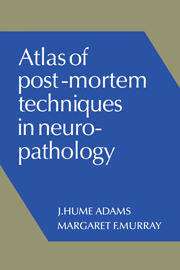Foreword
Published online by Cambridge University Press: 21 May 2010
Summary
There is no doubt that the ever–increasing number and variety of investigations applicable during life has led to considerable improvements in diagnostic practice, and in consequence there is now a tendency to downgrade the clinical importance of the autopsy. This is unfortunate, for every competent pathologist knows that, quite apart from its teaching value, autopsy commonly reveals lesions which, had they been appreciated earlier, would have influenced the management of the patient concerned. Indeed, this has been confirmed by recent collaborative studies between pathologists and clinicians practicing a high standard of patient care. Yet even the most conscientious pathologist may have difficulty in providing an adequate autopsy service, for the diagnostic biopsy service must claim first priority, and this has increased greatly as a result of advances in radiological and related procedures, in endoscopy and in needle biopsy techniques.
If the autopsy is to hold its place as a helpful investigative procedure and a means of medical audit, it is essential that it should be performed in such a way as to provide the greatest amount of useful information, and nowhere is technique more important than in the removal and preservation of the tissues dealt with in this book – the nervous and muscular systems and the eye. Unlike his clinical contemporaries, who have undergone a fair apprenticeship in the major bedside specialties during the medical school curriculum and early post–graduate training, the trainee pathologist has usually little or no previous practical experience in his intended specialty.
- Type
- Chapter
- Information
- Atlas of Post-Mortem Techniques in Neuropathology , pp. vii - viiiPublisher: Cambridge University PressPrint publication year: 1982

